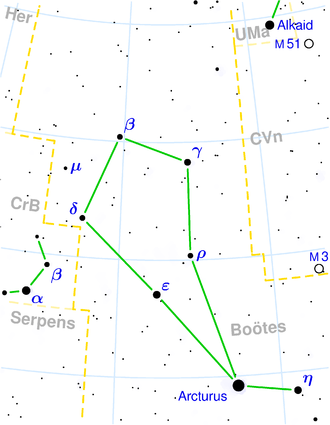NGC 5675
| Galaxy NGC 5675 |
|
|---|---|

|
|
| SDSS recording | |
| AladinLite | |
| Constellation | Bear keeper |
|
Position equinox : J2000.0 , epoch : J2000.0 |
|
| Right ascension | 14 h 32 m 39.8 s |
| declination | + 36 ° 18 ′ 08 ″ |
| Appearance | |
| Morphological type | SBb / LINER / Sy3 |
| Brightness (visual) | 12.8 mag |
| Brightness (B-band) | 13.6 mag |
| Angular expansion | 2.8 ′ × 1 ′ |
| Position angle | 137 ° |
| Surface brightness | 13.8 mag / arcmin² |
| Physical data | |
| Affiliation | LGG 385 |
| Redshift | 0.013252 ± 0.000087 |
| Radial velocity | (3973 ± 26) km / s |
|
Stroke distance v rad / H 0 |
(181 ± 13) · 10 6 ly (55.6 ± 3.9) Mpc |
| history | |
| discovery | William Herschel |
| Discovery date | May 1, 1785 |
| Catalog names | |
| NGC 5675 • UGC 9357 • PGC 51965 • CGCG 192-038 • MCG + 06-32-062 • IRAS 14305 + 3631 • 2MASX J14323987 + 3618083 • GC 3933 • H II 422 • h 1839 • LDCE 1069 NED002 | |
NGC 5675 is a bar-spiral galaxy with an active nucleus of the Hubble type SBb in the constellation Bear Guardian . It is an estimated 181 million light years from the Milky Way , about 150,000 ly in diameter, and is classified as a Seyfert 3 galaxy .
The object was discovered on May 1, 1785 by the astronomer William Herschel with the help of his 18.7-inch reflecting telescope and was later included in his New General Catalog by Johan Dreyer .
NGC 5675 group ( LGG 385 )
| Galaxy | Alternative name | Distance / million Lj |
|---|---|---|
| NGC 5675 | PGC 51965 | 181 |
| NGC 5684 | PGC 52179 | 187 |
| NGC 5695 | PGC 52261 | 193 |
